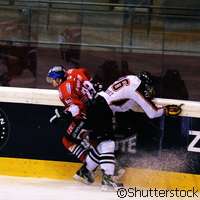Researchers investigate hockey board safety

Hockey is one of the toughest sports games. Players need both finesse and speed on the ice, but they also need to be strong. Being slammed into the boards or glass while chasing the puck is hard on the body. And the stronger the players get, the higher the number of injuries. Researchers in Finland investigated whether the shock-absorbing properties of different dasher board structures and materials can affect injury rates. Their findings show that the different types of boards' shock-absorbing properties varied significantly.
Researchers from the Department of Biology of Physical Activity at the University of Jyväskylä in Finland measured the physiological properties of body-checking against the boards in real-life game play and in a laboratory setting. With respect to the latter, the team calculated the maximum force inflicted on the board by body-checking and the displacement of the board. The numbers they generated helped them calculate the dasher board system.
The researchers found that the shock-absorbing properties of various board types were not similar. They identified a 25% difference in the impact forces measured from the most flexible board and from the conventional dual base frame. The glazing of the flexible board is made of plastic, while the glazing of the dual base frame is made of tempered glass.
They also observed significant differences in displacement. According to them, the displacement of the most flexible board was more than 130% greater in some cases, when compared with the reference board. They also found that the most flexible board had around 30% of the rigidity of its conventional counterpart.
The researchers said the shock-absorbing properties of metallic support posts in dasher board systems were inferior to those containing a flexible plastic shield.
The results show that the maximum impact force of a body check against a support post was up to 70% higher than the maximum impact force of a similar body check against a protective shield. They also found that the posts were up to five times more rigid than a plastic shield.
'By replacing the widely used tempered glass with a plastic shield, the impact force on players being body-checked against the boards is considerably reduced,' said Professor Janne Avela and researcher Piritta Poutiainen.
It should be noted that dasher board systems with a plastic shield and metallic posts are not a safe option, because the rigidity in metallic posts can cause injuries in players who body-check. It makes no difference if the plastic shield is flexible, the team said. Mitigating the force of impact is possible if the board's height is lowered. According to the researchers, this would allow the player who is body-checked to fall on the flexible shield.
















